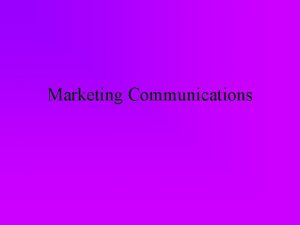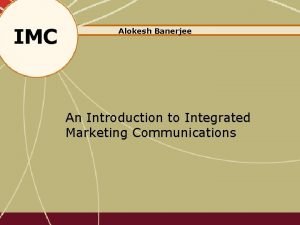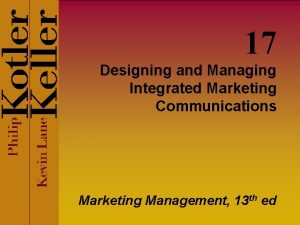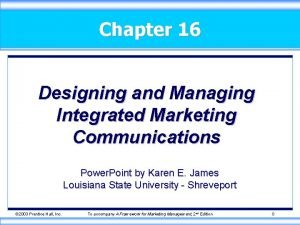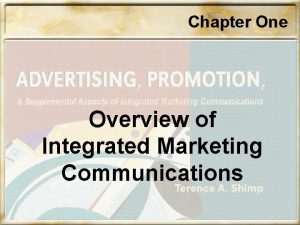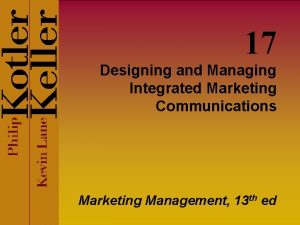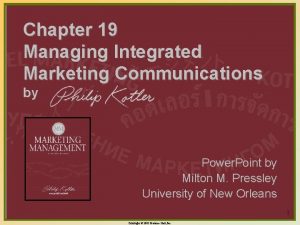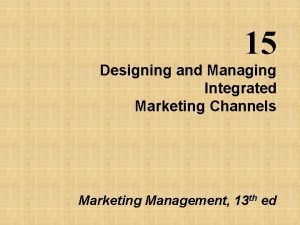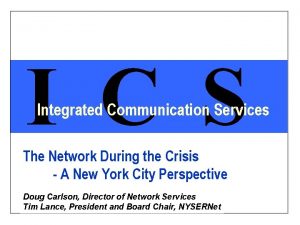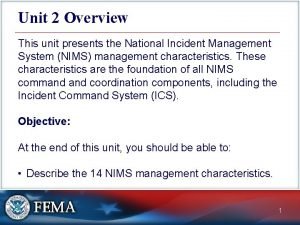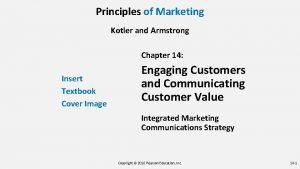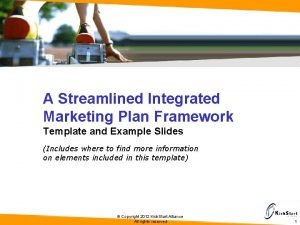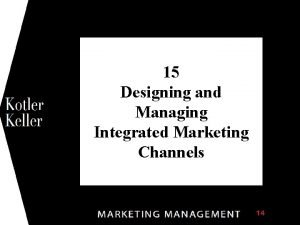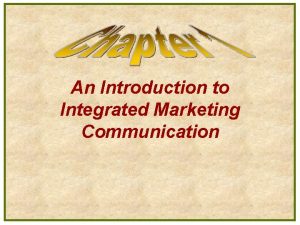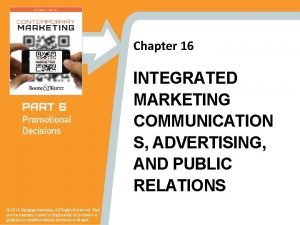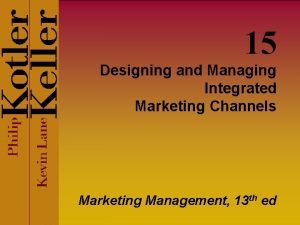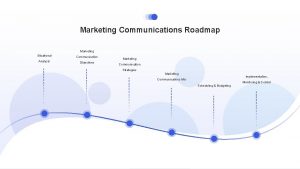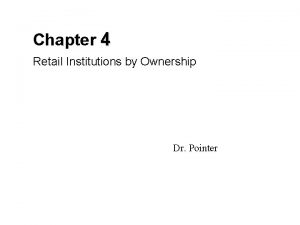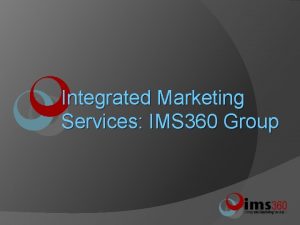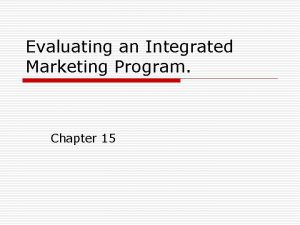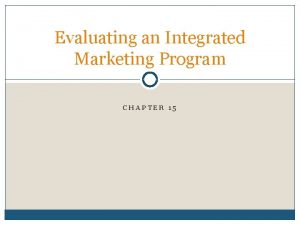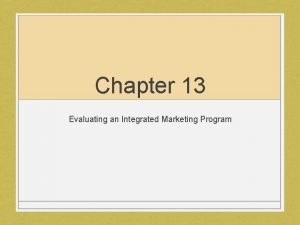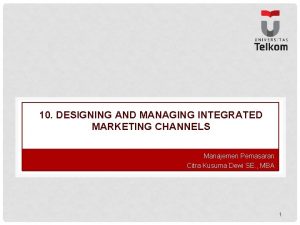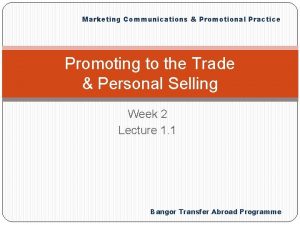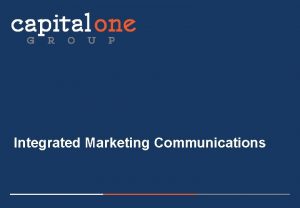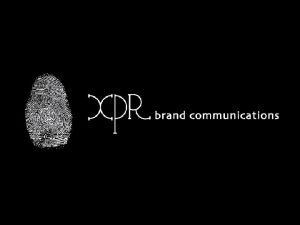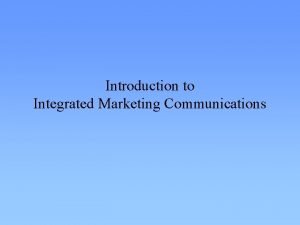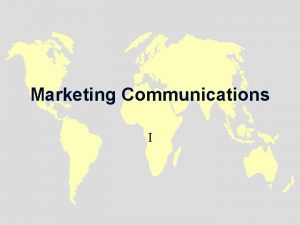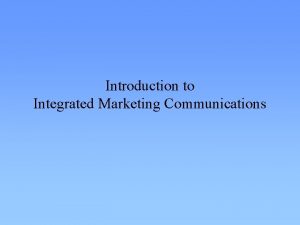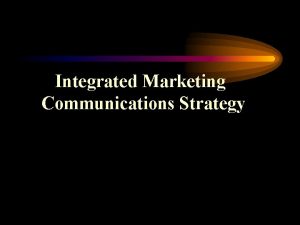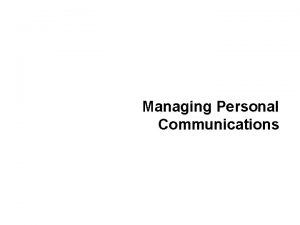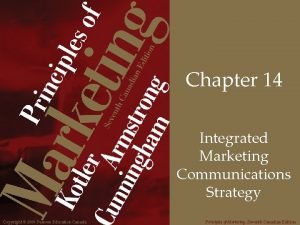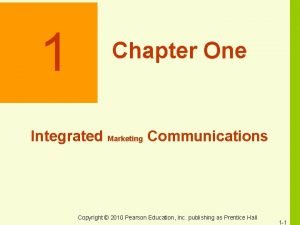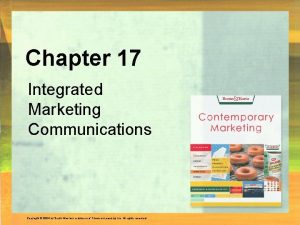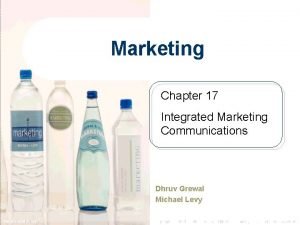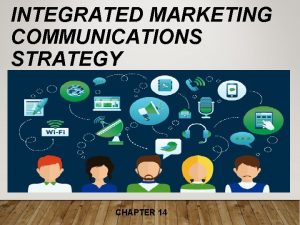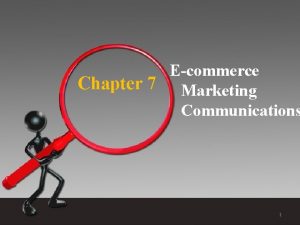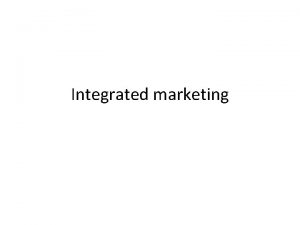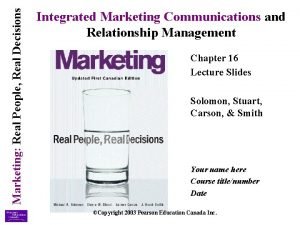Integrated Marketing Communications Chapter 11 Marketing Communications Copyright


























- Slides: 26

Integrated Marketing Communications Chapter 11 Marketing Communications Copyright 2006 Prentice Hall Publishing Company 1

Developing A Unique Selling Proposition (USP) USP - A key customer benefit of a product or service that answers the critical question that every customer asks: "What's in it for me? " n Identify your product or service's USP by describing the primary benefit it offers customers and then list other secondary benefits it provides. n Chapter 11 Marketing Communications Copyright 2006 Prentice Hall Publishing Company 2

Developing A Unique Selling Proposition (USP) Briefly list a few facts that support your product’s USP. n Then, focus your ads to stress these top benefits and the facts supporting them! n Chapter 11 Marketing Communications Copyright 2006 Prentice Hall Publishing Company 3

A Six-Sentence Advertising Strategy 1. 2. 3. 4. 5. 6. What is the purpose of this ad? What USP can you offer customers? What other key benefits support your USP? At whom are you aiming the ad? What response do you want from your target audience? What image do you want to convey in your ads? Chapter 11 Marketing Communications Copyright 2006 Prentice Hall Publishing Company 4

An Integrated Marketing Communications Plan Create specific, realistic, measurable objectives. n Identify and define target customers. n Design an marketing message and pick the appropriate media for communicating it. n Ø Build USP. Chapter 11 Marketing Communications the message around the company’s Copyright 2006 Prentice Hall Publishing Company 5

Elements of an Integrated Marketing Communications Plan n Advertising - any sales presentation that is nonpersonal in nature and is paid for by an identified sponsor. Publicity - any commercial news covered by the media that boosts sales but for which the small business does not pay. Personal selling - the personal contact between sales personnel and potential customers resulting from sales efforts. Chapter 11 Marketing Communications Copyright 2006 Prentice Hall Publishing Company 6

Fundamentals of a Successful Ad Copyright 2006 Prentice Hall Publishing Company 7

Tips for Stimulating Publicity n n n Write an article of interest to customers Sponsor an offbeat event to attract attention Involve celebrities “on the cheap” Offer to be interviewed on TV and radio stations Publish a newsletter Speak to local organizations n n n Write news releases and fax them to the media Sponsor a seminar Serve on community and industry boards and committees Sponsor a community project or support a nonprofit organization Promote a cause Copyright 2006 Prentice Hall Publishing Company 8

Sponsoring Special Events Don’t count on sponsorships for your entire advertising campaign. n Find an event that is appropriate for your company and its products and services. n Research the event and the organization hosting it before agreeing to become a sponsor. n Chapter 11 Marketing Communications Copyright 2006 Prentice Hall Publishing Company 9

Sponsoring Special Events (Continued) Try to become the dominant (or, better yet, the only) sponsor of the event. n Clarify the costs and the level of participation required for the sponsorship up front. n Get involved in the event. n Chapter 11 Marketing Communications Copyright 2006 Prentice Hall Publishing Company 10

Top Salespeople… n n n Are enthusiastic and alert to opportunities. Are experts in the products or services they sell and understand how their products and services can help their customers. Concentrate on select accounts with the greatest sales potential. Plan thoroughly. Use a direct approach with their customers. n n n Work from their customer’s perspective. Use past success stories and testimonial. Leave sales material with potential customers. See themselves as problem solvers, not just vendors. Measure success by customer satisfaction as well as by sales volume. Copyright 2006 Prentice Hall Publishing Company 11

Successful Personal Selling Requires a Selling System 1. 2. 3. 4. 5. 6. Create an atmosphere of trust and respect. Ask the prospect questions designed to reveal the criteria necessary to make the sale. Demonstrate, explain, and show the benefits of your product or service. Validate. Prove the claims about your product or service. Listen for objections and try to overcome them. Close the sale. Stop talking and ask for the order. Chapter 11 Marketing Communications Copyright 2006 Prentice Hall Publishing Company 12

Selecting Advertising Media: Key Questions How large is my firm's trading area? n Who are my customers and what are their characteristics? n Which media are most likely to reach those customers? n What budget limitations do I face? n Chapter 11 Marketing Communications Copyright 2006 Prentice Hall Publishing Company 13

Selecting Advertising Media: Key Questions (Continued) What media do my competitors use? n How important are repetition and continuity of my advertising message? n How does each medium compare with others in audience, reach, and frequency? n Chapter 11 Marketing Communications Copyright 2006 Prentice Hall Publishing Company 14

Comparing Media Audience – the number of paid subscribers a particular medium attracts. n Reach – the total number of people exposed to an ad at least once in a period of time, usually 4 weeks. n Frequency - the average number of times a person is exposed to an ad in that same time period. n Chapter 11 Marketing Communications Copyright 2006 Prentice Hall Publishing Company 15

Selecting Advertising Media: Key Questions (Continued) What media do my competitors use? n How important are repetition and continuity of my advertising message? n How does each medium compare with others in audience, reach, and frequency? n What does the advertising medium cost? n Chapter 11 Marketing Communications Copyright 2006 Prentice Hall Publishing Company 16

Copyright 2006 Prentice Hall Publishing Company 17

Advertising Media Options Word-of-mouth n Newspapers n Radio n Copyright 2006 Prentice Hall Publishing Company 18

Snappy Radio Copy Should. . Stress benefits to the listener. n Use attention-grabbers. n Zero in on a particular audience. n Be simple and to the point. n Sell early and often. n Chapter 11 Marketing Communications Copyright 2006 Prentice Hall Publishing Company 19

Snappy Radio Copy Should. . Be written for the ear. n Be rehearsed before presentation. n Use positive action words. n Put the listener in the picture. n Mention the advertiser often. n Chapter 11 Marketing Communications Copyright 2006 Prentice Hall Publishing Company 20

Advertising Media Options Word-of-mouth n Newspapers n Radio n Television n Magazines n Specialty advertising n Point-of-purchase ads n Copyright 2006 Prentice Hall Publishing Company 21

Advertising Media Options Word-of-mouth n Newspapers n Radio n Television n Magazines n Specialty advertising n Point-of-purchase ads n Outdoor ads n Transit advertising n Direct mail n World Wide Web n Directories n Trade shows n Copyright 2006 Prentice Hall Publishing Company 22

Preparing An Advertising Budget What is affordable n Matching competitor's advertising expenditures n Percentage of Sales n Ø Past Sales Ø Forecasted Sales n Objective-and-Task Chapter 11 Marketing Communications Copyright 2006 Prentice Hall Publishing Company 23

Chapter 11 Marketing Communications Copyright 2006 Prentice Hall Publishing Company 24

How To Advertise "Big" On A Small Budget Hire freelance copywriters and artists. n Use cooperative advertising. n Participate in shared advertising. n Maximize publicity with techniques such as cause marketing. n Chapter 11 Marketing Communications Copyright 2006 Prentice Hall Publishing Company 25

How To Advertise "Big" On A Small Budget (Continued) Repeat ads that have been successful. n Use identical ads in different media. n Hire independent copywriters, graphic designers, photographers, and other media specialists. n Concentrate advertising when customers are most likely to buy. n Chapter 11 Marketing Communications Copyright 2006 Prentice Hall Publishing Company 26
 Marketing encoding
Marketing encoding Integrated marketing communications definition
Integrated marketing communications definition Designing and managing integrated marketing communication
Designing and managing integrated marketing communication Marketing communication mix of coca cola
Marketing communication mix of coca cola Designing and managing integrated marketing communications
Designing and managing integrated marketing communications Overview of integrated marketing communications
Overview of integrated marketing communications Managing integrated marketing communications
Managing integrated marketing communications Designing and managing integrated marketing channels
Designing and managing integrated marketing channels Designing and managing integrated marketing channels
Designing and managing integrated marketing channels Integrated communications ics
Integrated communications ics Which nims management characteristics includes developing
Which nims management characteristics includes developing Kotler communication model
Kotler communication model Integrated marketing campaign template
Integrated marketing campaign template Designing and managing integrated marketing channels
Designing and managing integrated marketing channels Introduction to integrated marketing communication
Introduction to integrated marketing communication The sender of an integrated marketing communication
The sender of an integrated marketing communication High value deal seekers
High value deal seekers Integrated marketing roadmap
Integrated marketing roadmap Franchising in retailing
Franchising in retailing 360 integrated marketing
360 integrated marketing Evaluating an integrated marketing program
Evaluating an integrated marketing program Evaluating an integrated marketing program
Evaluating an integrated marketing program Evaluating an integrated marketing program
Evaluating an integrated marketing program Retail institutions
Retail institutions Evaluating an integrated marketing program
Evaluating an integrated marketing program Integrated marketing channel system
Integrated marketing channel system Push pull profile strategies marketing communications
Push pull profile strategies marketing communications
